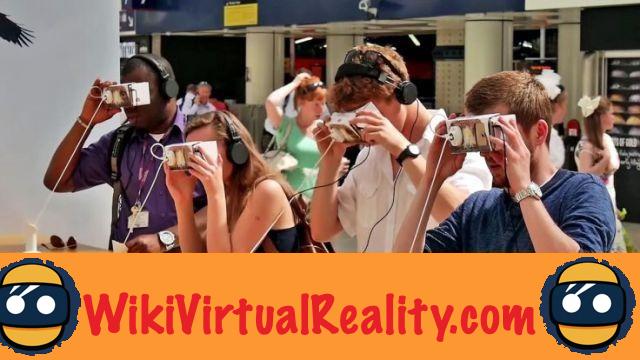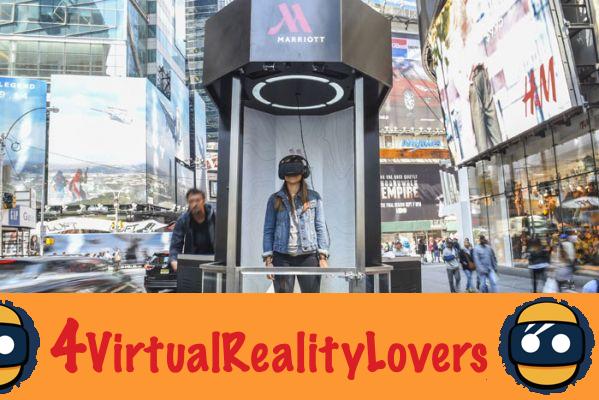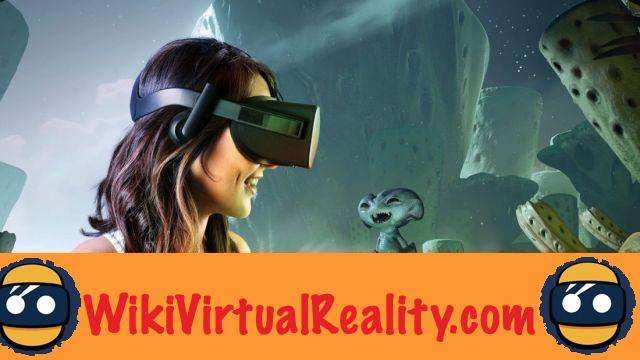
Summary
- VR Marketing: What is Virtual Reality Marketing?
- What are the benefits of VR marketing?
- VR marketing at the service of humanitarian aid
- How to do VR marketing? Some tips to apply
- VR Marketing: what are the limits?
- VR marketing: a market of 1,8 billion dollars by 2022?
- VR marketing: 6 examples of virtual reality marketing projects
Virtual reality is booming. Tech giants like Facebook, HTC and Google are all present in this new industry, and VR is gradually transforming all industries. This tsunami does not spare marketing. Through this dossier on VR marketing, discover how virtual reality is transforming marketing and how to get on the bandwagon before it's too late.
VR Marketing: What is Virtual Reality Marketing?

Concretely, VR marketing is a promotional use of virtual reality. It's all about using virtual reality for advertising purposes, to communicate in an innovative way using the possibilities offered by this new technology.
Most of the time, VR marketing takes the form virtual reality experiences created to promote a product, a service, or just a brand. These experiences can be video games, but also 360-degree animated films or any other form of less conventional VR experience.
On the other hand, it is advisable to do not confuse virtual reality with 360 degree videos. What is the difference ? 360-degree videos are filmed using 360-degree cameras, while virtual reality experiences are computer generated. Both are used using a virtual reality headset like the Oculus Rift or the HTC Vive, but their nature is different. In addition, VR experiences generally offer interactivity. 360-degree videos are also used for marketing, however.
According to Sarah Hills, CEO of StoryUP, those who think virtual reality will never go mainstream are the same people who thought that the mobile would never replace desktop PCs. In fact, just as it is unthinkable today not to offer a responsive version of a website, it will one day be mandatory to create a version adapted to virtual reality.
A report by Goldman Sachs Research seems to confirm this hypothesis. According to the document published in January 2016, Virtual reality headsets could one day become as ubiquitous as smartphones in our societies.
What are the benefits of VR marketing?

The main characteristic of virtual reality is immersion. Indeed, virtual reality experiences allow the user to immerse themselves in virtual universes, namely to have the impression of being physically present in the virtual world.
It is precisely this immersive potential that can be exploited as a valuable asset for marketing. If we consider that television and video ads are the evolution of print ads or picture marketing, then virtual reality is definitely the next step. For the first time, the viewer not only observes advertising content from the outside, but lives the experience from the inside.
So the content is more tangible, and the experience is more engaging for the viewer. Immersion arouses strong emotions, which makes it possible to capture the audience through feelings.
Another advantage of VR marketing is the novelty of this technology. As virtual reality is an emerging technology, most consumers have yet to experience it. Thus, companies that decide to use it for marketing improve their brand image by giving the impression of innovating and use the latest technologies.
According to the data aggregated by WebPageFX, the VR ads are much more effective as advertisements on mobile or desktop. Their success rate is 29,8%, compared to 1% for mobile ads and 0,4% for desktop ads. Likewise, the install rates from VR ads are 12,5% versus 0,5% on mobile ads and 0,2% on desktops ads.
VR marketing at the service of humanitarian aid

Virtual reality can also be used for humanitarian campaigns, thanks to its ability to arouse empathy in the user. Thus, in 2016, Amnesty International used virtual reality to raise public awareness of living conditions in Syria with the countryside.
This VR experience offered users the opportunity to immerse themselves in the ruins of Aleppo. In particular, we find testimonies from Syrians, as well as videos of bombing carried out by civilians. As a result of this campaign, the value of donations made to the organization increased by 16%. As Amnesty Internation UK director Kate Allen puts it, "If a picture is worth a thousand words, a virtual reality experience is worth a whole book".
In the same way, the Secours Catholique association created a VR film entitled "24 hours of happiness" offering viewers discover the daily life of a single mother in a precarious situation. The objective of this project is to generate empathy among deputies in order to encourage them to fight against poverty.
How to do VR marketing? Some tips to apply

There is obviously no miracle recipe for marketing in VR. However, several tips can be applied. First of all, to create good VR experiences, it is best to take a close interest in VR. Immerse yourself. Spend time learning about this new technology, including trying out VR marketing content from other companies that have seen significant ROI. This is how you will discover the potential of VR marketing.
Beforehand, also take the time to set a budget for your VR marketing campaign. There are different types of virtual reality experiences, and some are significantly more ambitious than others. If you want to create a real video game or a complex interactive experience, it is best to hire a professional studio. On the other hand, it is possible to start small with a relatively simplistic experience.
To do this, you can in particular call on specialized networks like Virtual Sky and VadR. However, these networks do not allow for tailor-made VR experiences, and their offerings can ultimately prove counterproductive to your marketing strategy. The advertising experiences they develop are not of excellent quality. So before you hire a third party for your VR marketing, be sure to carefully review their previous work and different offerings.
If you are unsure whether you can create quality VR content for your marketing, an alternative may be to advertise yourself in a virtual reality experience developed by a third party. For example, you can partner with a VR video game developer to integrate your logo or brand name into the game. In virtual reality, a simple logo around the corner of a street can be very striking. for the user.
Either way, remember that virtual reality is a means and not an end in itself. Certainly, VR is new and therefore generates more interest than traditional channels. However, a good VR marketing experience doesn't have to be based on this technology alone. It must provide real emotions or sensations.
Rather than developing a short-term marketing campaign, it may be wise to think in the long term by creating an application that you will be able to update regularly with new content: coverage of live events, presentations of new products in VR ... create your VR application and offer it on the various application stores, while remembering to include VR and Virtual Reality in the title and description. A VR headset as an icon can also help attract attention.
VR Marketing: what are the limits?

According to Marketo, only 30% of B2C companies in Forbes Global 2000 started to use VR marketing. Likewise, according to a survey conducted by Yes Lifecycle Marketing, 57% of retail brands believe that virtual reality is not relevant for their businesses.
According to Yes Lifecycle Marketing, the main fear of marketers is to not being able to offer as much customization in VR experiences than through other more traditional channels. Indeed, while a one-size-fits-all approach may be relevant to promoting the Bladerunner 2049 movie in VR, things are different when it comes to selling clothing. It is currently difficult to customize VR for each user.
There are already several examples of successful VR marketing campaigns. For example, l’application VR du New York Times has been downloaded over 50 times when it was launched. However, this success is mainly linked to the fact that virtual reality is particularly suited to journalism. This is not necessarily the case for a clothing salesperson or a software publisher. These are the limits of VR marketing.
Another problem to be overcome in the field of VR marketing is the low adoption rate of virtual reality headsets. In fact, in 2016, only 6,3 million people worldwide owned a VR headset. Fact, the audience for VR marketing campaigns remains very limited. Outside of the event framework, very few people will be affected by these projects.
However, most analysts (especially IDC) predict strong growth in the virtual and augmented reality headset market. In 2018, CCS estimates that 22 million VR / AR headsets will be sold worldwide. The reach of virtual and augmented reality campaigns is therefore increasing sharply. This market growth is notably linked to the appearance of stand-alone VR headsets which are much more affordable, such as the Oculus Go priced at 199 euros, and the arrival of augmented reality headsets such as the Magic Leap One.
A second hurdle for VR marketing to overcome is the cost of developing experiences. Even a low-quality virtual reality film costs on average between 10 and 000 euros to produce. A more successful film costs at least 40 euros. Marketing in virtual reality therefore seems for the moment reserved for large companies, but the costs should decrease as the market evolves.
VR marketing: a market of 1,8 billion dollars by 2022?

According to ABI Research, virtual reality in marketing and retail could generate $ 1,8 billion in 2022. It is the innovations within the virtual reality industry that are expected to improve the effectiveness and impact of VR marketing. The more advanced the technology, the more effective its use for marketing.
At the moment, only a few companies are using this technology, but it may soon become the norm. VR marketing is already being used in several industries such as the automotive industry, tourism, and interior design, and many other industries will adopt it over time. As ABI Research analyst Khin Sandi Lynn explains, VR marketing helps meet growing demand for a more satisfying shopping experience from consumers.
VR marketing: 6 examples of virtual reality marketing projects
Enough with theory, make way for the concrete! Now that you know all about VR marketing, it's time to check out a selection of 6 examples of successful virtual reality marketing projects.
Pepsi Superbowl 2018

As part of the 2018 Superbowl, Pepsi partnered with Google Zoo to create one of the most successful VR marketing experiences yet. The user embarks on a journey aboard the Delorean from the film Back to the Future, and this vehicle will allow him to travel through time to… relive the various mythical advertisements of Pepsi in virtual reality.
A way of link the past to the present in order to stimulate the viewer's nostalgia. When launching the experience, only 2 advertisements can be explored VR. This is the 1998 spot with pilot Jeff Gordon, and the 1991 spot set in the desert with Cindy Crawford. Subsequently, other cult advertisements will be added to the experience.
One of the main strengths of this experience and that the user can interact with the different elements decor to trigger contextual events. The user is therefore not content to be a passive spectator.
Key Technology VERYX Food Sorting
As part of the Pack Expo trade fair, the food processing system manufacturer Key Technology created a virtual reality demo. This experience allows visitors to the show to find out how the VERYX digital food sorting platform works of the company.
This is a B2B VR marketing experience, allowing the firm's potential partners to discover how VERYX works and to see its effectiveness. The 360-degree video above only captures part of the experience, which also offered some interactivity.
Oreo and 360i
In early 2016, Oreo partnered with 360i to create a 360-degree virtual reality video to promote their new Filled Cupcake Flavored cookie. The video transports the viewer to an imaginary world, inviting him to sail on rivers of milk between canyons of chocolate.
While this VR marketing experience is sorely lacking in interactivity, the combination of a 360-degree view and an animated, CGI world manages to stimulate the viewer's imagination. And to him make you want to eat Oreo cookies.
Lowe’s Holoroom How To
Renovation is a subtle discipline. Many consumers are afraid to take the plunge, fearing that they may lack knowledge or skills. It is to respond to this problem that Lowe's launched its VR Holoroom How To experience on Oculus Rift in 19 of its stores.
It is actually a virtual reality experience to practice painting a wall, to lay tiles in a bathroom, or to change the piping. The user can then share the result of his virtual work with his friends to collect their feedback, before possibly going into the real world. Thus, Lowe's is able to sell more products to its customers and also benefit from better visibility.
Volvo Reality

With Volvo Reality, Volvo has created the first virtual reality test drive. Available on any VR headset, this experience allows users to try out the XC90 SUV in virtual reality.
This VR marketing project has enabled Volvo to garner 238 million PR impressions, 159 million paid press impressions, 19 million social media impressions, 4 million video views, 24 articles and nearly 500 visits to its website. The XC000 was also found in out of stock in less than two days. A real triumph, in a context where Volvo has been losing market share in the United States for almost 10 years.
Boursin Sensorium
The spreadable cheese giant, Boursin, created the VR Boursin Sensorium experience to offer users a magical journey in a full fridge. The opportunity to discover different recipes that can be made with Boursin.
Created in partnership with BecauseXM and Hammerheadvr, this experience combines virtual reality headset and moving chair to deliver thrills to users and mark their minds. The project was presented at various shopping centers and events in the UK.


























